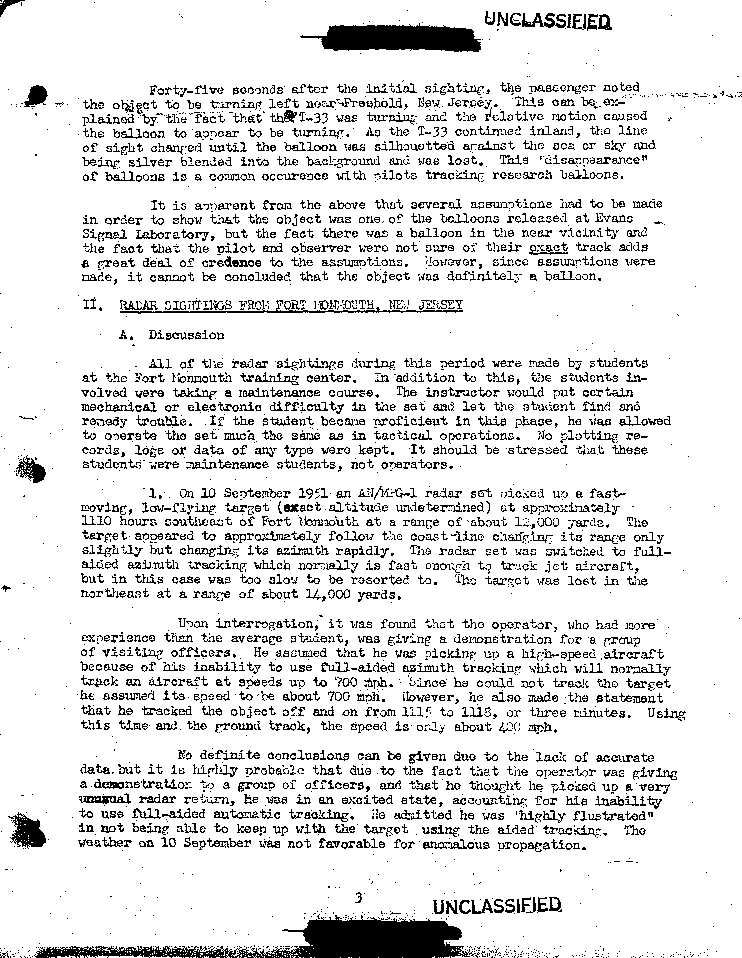1951.
1 2 3 4 5 6 7 8 9 10 11 12 13 14 15 16 17 18 19 20 21 22 23 24 25 26 27 28 29 30 31

|
Forty-five seconds after the initial sighting, the passenger noted the object to be turning left near Freehold, New Jersey. This can be explained by the fact that the T-33 was turning and the relative motion caused the balloon to appear to be turning. As the T-33 continued inland, the line of sight changed until the balloon was silhouetted against the sea or sky and being silver blended into the background and was lost. This "disappearance" of balloons is a common occurrence with pilots tracking research balloons.
It is apparent from the above that several assumptions had to be made in order to show that the object was one of the balloons released at Evans Signal Laboratory, but the fact that there was a balloon in the near vicinity and the fact that the pilot and observer were not sure of their exact track adds a great deal of credence to the assumptions. However, since assumptions were made, it cannot be concluded that the object was definitely a balloon.
II. RADAR SIGHTING FROM FORT MONMOUTH, NEW JERSEY
A. Discussion
All of the radar sightings during this period were made by students at the Fort Monmouth training center. In addition to this, the students involved were taking a maintenance course. The instructor would put certain mechanical or electronic difficulty in the set and let the student find and remedy trouble. If the student became proficient in this phase, he was allowed to operate the set much the same as in tactical operations. No plotting records, logs or data of any type were kept. It should be stressed that these students were maintenance students, not operators.
1. On 10 September 1951 an AN/MPG-1 radar set picked up a fast-moving, low flying target (exact altitude undetermined) at approximately 1110 hours southeast of Fort Monmouth at a range of about 12,000 yards. The target appeared to approximately follow the coast line changing its range only slightly but changing its azimuth rapidly. The radar set was switched to full aided azimuth tracking which normally is fast enough to track jet aircraft, but in this case was too slow to be resorted to. The target was lost in the northeast at a range of about 14,000 yards.
Upon interrogation, it was found that the operator, who had more experience than the average student, was giving a demonstration for a group of visiting officers. He assumed that he was picking up a high speed aircraft because of his inability to use full-aided azimuth tracking which will normally track an aircraft at speeds up to 700 mph. Since he could not track the target he assumed its speed to be about 700 mph. However, he also made the statement that he tracked the object off and on from 1115 to 1118, or three minutes. Using this time and the ground track, the speed is only about 400 mph.
No definite conclusions an be given due to the lack of accurate data but it is highly probable that due to the fact that the operator was giving a demonstration to a group of officers, and that he thought he picked up a very unusual radar return, he was in an excited state, accounting for his inability to use full-aided automatic tracking. He admitted he was "highly frustrated" in not being able to keep up with the target using the aided tracking. The weather on 10 September was not favorable for anomalous propagation.
1951.
1 2 3 4 5 6 7 8 9 10 11 12 13 14 15 16 17 18 19 20 21 22 23 24 25 26 27 28 29 30 31